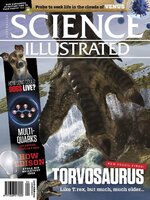Science Illustrated delivers natural science, break through discoveries and an understanding of the world for the entire family. Packed with stunning photography and in-depth editorial it’s a visually spectacular gateway to the world looking into the beginning of life to distant objects in the universe.
SUBSCRIBE TO SCIENCE ILLUSTRATED
Science Illustrated
Leaf landscape: an extreme close-up reveals oak details
Stork stalking: eagle’s surprise attack steals fish
Mini ‘brains’ made in a lab develop eyes • German scientists have manipulated lab-made mini ‘brains’ into developing the first stages of eyes – and vision systems.
Mars base could be built on blood, sweat, and… urine • Substances from astronauts’ own bodies can be used as binders that convert Mars dust into strong concrete.
Zigzagging jet stream could drown Scandinavia • Global warming is forcing the high-altitude wind phenomenon north, potentially shifting weather patterns across the Northern Hemisphere.
Crocodile eats dinosaur! • Neutron imaging of delicate fossils reveals what an ancient crocodile had for dinner.
Tropical sea cucumbers in trouble from over-harvesting • A delicacy on the table, but critical for ocean ecosystems.
The world’s biggest drone to launch satellites • In its heaviest version so far, the Ravn X giant drone could create a new route to space and allow new drone-based freight services down here on Earth.
Toilet-trained cows could protect the planet • To reduce pollution from cow excrement, scientists are developing a way to persuade cows into using a toilet.
Vaccine patch is better than needles • A patch with tiny needles coated in vaccine could replace future injections.
Who discovered America? (Hint: it’s not Columbus.) • Well-preserved footprints prove that humans conquered America 7000 years earlier than thought – and that it probably happened by boat.
How much air pollution is space tourism creating? • Several companies allow ordinary people to become ‘space tourists’, paying to travel into space. But will all the extra rocket launches for space tourism create a marked rise in air pollution?
TOP 5 · Which animal collects most food? • Many animals collect supplies during the warm seasons to see them through winter. But which collect the most?
Is the noise from wind turbines unhealthy? • Turbine noise itself shouldn’t make people ill, provided the turbines are at sufficient distance. But its continuous nature and the additional element of visual pollution may have ill effects.
Could you photograph an exoplanet directly? • Is it possible to photograph planets orbiting alien stars?
What is a neuromorphic camera?
How deep underground can we build and live? • How deep into the ground is it possible to build and stay? And what are the challenges?
Can carbon capture help clean up ‘dirty’ industries? • Carbon capture and storage has been included in the figures for some environmental plans, including those in Australia, before the technology even exists.
…killer whales hunt blue whales? • Only in 2019 did scientists first record killer whales hunting and killing an adult blue whale.
SPACEPORTS ARE MOVING TO THE OCEAN • The classic image of a rocket launch is from a dry launchpad. But aerospace companies are realising the advantages of launching from the ocean. Modified drilling rigs will make aerospace safer and cheaper – and perhaps take us on holiday at unprecedented speeds.
Ships and drilling rigs will become rocket bases • Both private aerospace companies and China’s national space agency are investigating the advantages of launching space rockets from the ocean. Floating platforms can also be used for landings so that rocket parts can be...

 Issue 111
Issue 111
 Issue 110
Issue 110
 Issue 109
Issue 109
 Issue 108
Issue 108
 Issue 107
Issue 107
 Issue 106
Issue 106
 Issue 105
Issue 105
 Issue 104
Issue 104
 Issue 103
Issue 103
 Issue 102
Issue 102
 Issue 101
Issue 101
 Issue 100
Issue 100
 Issue 99
Issue 99
 Issue 98
Issue 98
 Issue 97
Issue 97
 Issue 96
Issue 96
 Issue 95
Issue 95
 Issue 94
Issue 94
 Issue 93
Issue 93
 Issue 92
Issue 92
 Issue 91
Issue 91
 Issue 90
Issue 90
 Issue 89
Issue 89
 Issue 88
Issue 88
